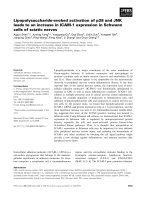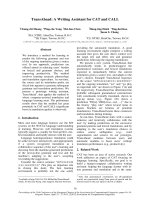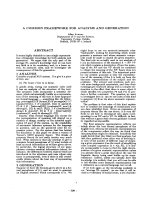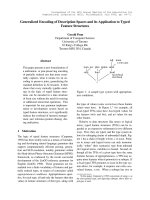Báo cáo khoa học: "A Medical Emergency Team syndromes and an approach to their management" ppsx
Bạn đang xem bản rút gọn của tài liệu. Xem và tải ngay bản đầy đủ của tài liệu tại đây (85.71 KB, 4 trang )
Open Access
Available online />Page 1 of 4
(page number not for citation purposes)
Vol 10 No 1
Research
Medical Emergency Team syndromes and an approach to their
management
Daryl Jones
1
, Graeme Duke
2
, John Green
2,3
, Juris Briedis
3
, Rinaldo Bellomo
4
,
Andrew Casamento
2
, Andrea Kattula
5
and Margaret Way
5
1
Intensive Care Unit, The Alfred Hospital, Commercial Road Melbourne, Victoria, Australia, 3004
2
Intensive Care Unit, The Northern Hospital, Cooper Street Epping, Victoria, Australia, 3076
3
Department of Anaesthesia, The Northern Hospital, Cooper Street Epping, Victoria, Australia, 3076
4
Department of Intensive Care and Department of Surgery, The Austin Hospital, Studley Road Heidelberg, Victoria, Australia, 3084
5
Department of Strategy Risk and Clinical Governance, The Austin Hospital, Studley Road Heidelberg, Victoria, Australia, 3084
Corresponding author: Rinaldo Bellomo,
Received: 29 Dec 2005 Accepted: 19 Jan 2006 Published: 15 Feb 2006
Critical Care 2006, 10:R30 (doi:10.1186/cc4821)
This article is online at: />© 2006 Jones et al.; licensee BioMed Central Ltd.
This is an open access article distributed under the terms of the Creative Commons Attribution License ( />),
which permits unrestricted use, distribution, and reproduction in any medium, provided the original work is properly cited.
Abstract
Introduction Most literature on the medical emergency team
(MET) relates to its effects on patient outcome. Less information
exists on the most common causes of MET calls or on possible
approaches to their management.
Methods We reviewed the calling criteria and clinical causes of
400 MET calls in a teaching hospital. We propose a set of
minimum standards for managing a MET review and developed
an approach for managing common problems encountered
during MET calls.
Results The underlying reasons for initiating MET calls were
hypoxia (41%), hypotension (28%), altered conscious state
(23%), tachycardia (19%), increased respiratory rate (14%) and
oliguria (8%). Infection, pulmonary oedema, and arrhythmias
featured as prominent causes of all triggers for MET calls. The
proposed minimum requirements for managing a MET review
included determining the cause of the deterioration,
documenting the events surrounding the MET, establishing a
medical plan and ongoing medical follow-up, and discussing the
case with the intensivist if certain criteria were fulfilled. A
systematic approach to managing episodes of MET review was
developed based on the acronym 'A to G': ask and assess;
begin basic investigations and resuscitation, call for help if
needed, discuss, decide, and document, explain aetiology and
management, follow-up, and graciously thank staff. This
approach was then adapted to provide a management plan for
episodes of tachycardia, hypotension, hypoxia and dyspnoea,
reduced urinary output, and altered conscious state.
Conclusion A suggested approach permits audit and
standardization of the management of MET calls and provides
an educational framework for the management of acutely unwell
ward patients. Further evaluation and validation of the approach
are required.
Introduction
Medical emergency team (MET) systems have been intro-
duced into hospitals to identify, review and treat acutely unwell
ward patients. Most of the literature related to METs has con-
centrated on their effects in reducing cardiac arrests and seri-
ous adverse events [1], primarily in single-centre studies.
However, a recent Australian multi-centre cluster-randomized
trial failed to confirm that the introduction of METs into hospi-
tals was able to improve these outcomes [2]. Despite this neg-
ative result, substantial interest in the utility of METs has
developed in both the USA and the UK.
Limited information exists on the causes and outcomes of epi-
sodes of MET reviews. There is even less information on the
process of assessment and management undertaken by the
MET during an episode of MET review. To our knowledge, no
information exists on a systematic approach to managing MET
calls.
ICU = intensive care unit; MET = medical emergency team.
Critical Care Vol 10 No 1 Jones et al.
Page 2 of 4
(page number not for citation purposes)
It is likely that a limited number of conditions precipitate MET
calls [3] and that a MET syndrome or several MET syndromes
exist [1].
We present here a systematic approach for the assessment
and management of problems commonly encountered during
an episode of MET review.
Methods
The hospitals
The Northern and Austin Hospitals are both situated in the
north of Melbourne and are affiliated with the University of Mel-
bourne. The Northern Hospital provides acute and elective
medical services, except cardiac surgery, neurosurgery and
organ transplantation. The Austin Hospital provides all acute
and elective medical services and is the referral centre for liver
transplantation and spinal cord injuries for the state of Victoria.
The Northern Hospital has a 10-bed intensive care unit (ICU)
that is staffed by an intensive care registrar during the day, and
a senior hospital medical officer and anaesthetic registrar
overnight. The Austin Hospital has a 21-bed ICU that is staffed
by intensive care registrars at all times. In both hospitals the
ICU medical staff may have a background in anaesthesia, inter-
nal medicine or emergency medicine.
Ethics approval
Approval for the introduction of the MET and for the collection
of data related to it was obtained from the Hospital Research
and Ethics Committee of both hospitals.
Medical response teams
Both hospitals have two levels of emergency response. The
traditional 'Code Blue' call is intended for the resuscitation of
cardiac arrests and other acute life-threatening emergencies.
It consists of an anaesthetic registrar, a coronary care registrar
and nurse, an ICU registrar and nurse, and the medical regis-
trar of the receiving unit of the day. The MET is intended to
review all medical emergencies other than cardiac arrests; it
has been described in detail previously [4]. It can be activated
by any member of hospital staff according to predetermined
criteria that are based primarily on abnormalities of vital signs
and clinical status (Table 1 in Additional file 1).
At the Austin hospital the MET consists of an ICU registrar and
nurse, as well as the Medical registrar of the receiving unit of
the day. Previously, activation of the MET at the Northern Hos-
pital resulted in notification of only the patient's parent unit
doctors. As part of an ongoing programme to improve the use
of the MET at the Northern Hospital, activation of the MET now
results in notification of the medical registrar and the intensive
care registrar or hospital medical officer.
Details of MET calls
A detailed log book is maintained by the switchboard opera-
tors at both hospitals that records all medical emergency calls.
At the Austin Hospital, case report forms are also completed
by the ICU registrar at the end of each call. These forms doc-
ument the parent unit of the patient as well as the indications
for the MET call. Since March 2002 the registrar has also
recorded a provisional diagnosis of what medical condition is
thought to have caused the MET call. Details of 400 calls that
occurred between April and October 2004 were manually
entered into an Excel spreadsheet to provide details on the
trigger and the presumed aetiology of the call. Data are pre-
sented as percentages or absolute number of calls. No
assumptions are made in cases in which data on presumed
diagnosis were missing.
Proposed minimum standards for managing a MET call
The proposed minimum standards were developed after a
series of meetings and electronic communications between all
the authors of this manuscript. The 'A to G' approach to man-
aging a MET call was subsequently developed to achieve
these minimal standards. Finally, the 'A to G' approach was
adapted to provide a plan for the management of the five most
common 'MET syndromes': tachycardia, hypotension, dysp-
noea and hypoxia, altered conscious state, and oliguria.
Results
Characteristics of 400 MET calls
Of the 400 MET calls, 23 had only the 'staff worried' criterion.
Of the remainder, 248 had one listed physiological MET crite-
rion, 105 had two, 23 had three and one patient had four cri-
teria. The average number of listed MET criteria for the 400
MET calls was 1.3 (531 criteria for 400 calls).
The proportions of MET criteria triggering a call were hypoxia
(41%), hypotension (28%), altered conscious state (23%),
tachycardia (19%), increased respiratory rate (14%) and olig-
uria (8%). Of the 531 calling criteria for the 400 MET calls, 61
had no documented provisional diagnosis. Several common
causes for these triggers were identified (Table 2 in Additional
file 1). Infections (especially pneumonia; 125/531 criteria),
cardiogenic shock or pulmonary oedema (104/531 criteria)
and arrhythmias (51/531 criteria) were thought to be respon-
sible for 53% (280/531) of all triggers for MET calls (Table 2
in Additional file 1).
Proposed minimum standards for managing a MET call
The proposed minimum requirements for managing an epi-
sode of a MET review included the following: first, determining
the cause of the deterioration; second, documenting the
events surrounding the MET; third, establishing a medical plan
and ongoing medical follow-up; and fourth, discussing the
case with the intensivist if predefined criteria were fulfilled
(Table 3 in Additional file 1). Requirements specific to the Aus-
tin Hospital also included automatic medical referral for surgi-
cal patients who remained on the ward after a MET call for a
medical reason, and compulsory review of the patient by an
Available online />Page 3 of 4
(page number not for citation purposes)
intensivist for a patient requiring two MET reviews in a seven-
day period.
Approach to the management of a MET call
An approach to the management of a MET call was developed
with the acronym 'A to G' (Table 4 in Additional file 1). The
members of the MET are encouraged to ask the nurses the
reason for the MET call (that is, what calling criteria initiated
the MET call) and assess the patient for the aetiology of the
deterioration before beginning basic resuscitation. They are
also encouraged to call for help if needed. After initial resusci-
tation and assessment, the staff are instructed to discuss the
case with appropriate medical staff, decide where the patient
should be managed, and document the events surrounding
the MET. Issues surrounding the resuscitation status of the
patient should also be discussed if appropriate. Once a man-
agement plan has been established, the members of the MET
are encouraged to explain the cause of the call and subse-
quent management and follow-up plan to the medical and
nursing staff, the patient and/or their next of kin. The subse-
quent frequency of monitoring of vital signs should also be dis-
cussed, as should the criteria for doctor re-notification. Finally,
the members of the MET are encouraged to graciously thank
staff for their help with the MET call.
In addition to these guidelines, emphasis is placed on three
principles regarding MET call management: first, always be
helpful; second, never criticize the staff for making the call, or
for the management of the patient; and third, always remain
calm and concentrate on the management of the patient.
Management of the 'hypoxic/tachypnoeic MET call'
Using the framework of the acronym 'A to G', a plan was devel-
oped for the management of an episode of MET review initiated
for a patient who is hypoxic or tachypnoeic (Table 5 in Additional
file 1). Similar plans were developed for the management of the
'hypotensive MET call', the 'tachycardic MET call', the 'oliguric
MET call' and, finally, the 'altered conscious state MET call'.
The aetiology and features of the common causes of the call
are listed, as well as an approach to the management of each
cause. In addition, criteria for seeking assistance or for notify-
ing the intensivist are listed.
Discussion
We conducted a study to determine the most common rea-
sons for initiating 400 MET calls in a teaching hospital. In addi-
tion, we proposed minimum standards for the management of
a MET call and developed a systematic framework for the
assessment, management and referral of the various 'MET syn-
dromes' that resulted in these calls.
Most of the literature related to METs has concentrated on
their effects in reducing cardiac arrests and serious adverse
events [1], primarily in single-centre studies.
Limited information exists on the cause of MET calls, and there
is even less information on the process of assessment and
management undertaken by the MET during an episode of
MET review. To our knowledge, no information exists on a sys-
tematic approach to the management of such episodes.
Our analysis of 400 recent MET calls at the Austin Hospital
revealed initial evidence supporting previous opinion that MET
calls are likely to be made for a limited number of conditions
[3] and that a MET syndrome or several MET syndromes exist
[1]. Infections, pulmonary oedema, and arrhythmias featured
as prominent causes of the 400 MET calls analysed. These
syndromes have defined aetiologies and treatments.
At least two other studies have assessed the abnormalities
leading to the activation of a MET service. In the original
description of the MET, Lee and colleagues. [5] analyzed the
cause of 522 MET calls, 148 of which were cardiac arrests
and 62% of which occurred in the Emergency Department.
The most common causes of MET calls in this study were
acute respiratory failure, status epilepticus, coma, and severe
drug overdose. Kenward and colleagues. [6] analysed 136
MET calls over a 12-month period and found that altered con-
scious state, hypoxia, tachypnea, hypotension and tachycardia
were the commonest precipitants. An audit of 80 MET calls at
the Northern Hospital in 2001 revealed that alteration in con-
scious state, hypotension, and noisy breathing were the com-
monest precipitants (Duke, G; unpublished data). These
findings highlight the need to assess regional variations in the
epidemiology of MET calls.
At least two other approaches exist that teach junior medical
staff to manage acutely unwell hospital patients. The ALERT™
course was developed by staff affiliated with the University of
Portsmouth [7,8]. The course provides an overall plan of
assessment as well as approaches to the 'blue and breathless
patient', 'the patient with a disordered conscious level' and 'the
oliguric patient'. The 'A to G' approach outlined in this article
provides information about the aetiology, management and
recommendations for referral and follow-up of patients with
these and other syndromes.
The CCrISP course was developed by the Royal College of
Surgeons (England) and is a two-day course aimed at surgical
house officers [9]. The 'A to G' approach outlined in this article
is aimed primarily at medical and intensive care registrars and
fellows, and incorporates acute deteriorations of both medical
and surgical patients. It emphasizes the need to establish a
diagnosis of the aetiology of the call and to establish a man-
agement and follow-up plan for the patient. In addition, we
have included strategies to facilitate communication between
members of the MET and the parent unit of the patient. Finally,
we have emphasized the importance of not criticizing ward
staff for initiating the call. Fear of criticism has been shown to
be an obstacle for the activation of MET services [10,11].
Critical Care Vol 10 No 1 Jones et al.
Page 4 of 4
(page number not for citation purposes)
Our study has several strengths and limitations. Our approach
lends itself to education of the members of the MET and audit-
ing of the MET review process. It is tailored for the team
approach of the MET that involves an initial assessment and
coordination of ongoing care. The other major strength of the
approach is the ability to adapt it to the requirements of differ-
ent hospitals. First, the 'MET syndromes' can be adapted
according to the case mix and demographics of the patients at
a given hospital to reflect the most common criteria and
causes for the initiation of a MET call. Second, the details of
the management plans can be altered according to local med-
ical opinion and to reflect the level of experience of members
of the MET. Third, it is possible to apply more objective and
specific criteria for the notification of senior members of med-
ical staff (for example, call the intensivist if the patient remains
hypotensive despite receiving 3 litres of fluid).
The major limitation of the approach is that it has not been val-
idated. We are currently implementing a detailed education
programme at the Northern Hospital based on these recom-
mendations that seeks to improve the documentation and out-
come of patients who receive a MET review.
Conclusion
We reviewed 400 MET calls and found that five syndromes
accounted for essentially all MET calls observed; More than
90% of calls were associated with hypoxia, hypotension or
altered conscious state. Sepsis, pulmonary oedema and
arrhythmias were the most common triggers of MET calls and of
the above syndromes. In response to these observations, we
propose an approach that permits audit and standardization of
the management of MET calls and provides an educational
framework for the management of acutely unwell ward patients.
Further evaluation and validation of the approach are required.
Competing interests
The authors declare that they have no competing interests.
Authors' contributions
DJ, GD, JG, JB, AC and RB were responsible for the design of
the study. DJ, AC and RB collected the data. DJ, GD and RB
performed the data analysis. All authors performed the critical
data review and prepared the manuscript. All authors read and
approved the final manuscript.
Additional files
Acknowledgements
We thank the nurses and doctors who provide the MET services with
great dedication and competence every day.
References
1. DeVita M: Medical emergency teams: deciphering clues to cri-
ses in hospitals. Critical Care 2005, 9:325-326.
2. MERIT study investigators: Introduction of the medical emer-
gency team (MET) system: a cluster-randomised controlled
trial. Lancet 2005, 365:2091-2097.
3. Runciman WB, Merry AF: Crisis in clinical care: an approach to
management. Qual Saf Health Care 2005, 14:156-163.
4. Bellomo R, Goldsmith D, Uchino S, Buckmaster J, Hart GK,
Opdam H, Silvester W, Doolan L, Gutteridge G: A prospective
before-and-after trial of a medical emergency team. Medical
Journal of Australia 2003, 179:283-287.
5. Lee A, Bishop G, Hillman KM, Daffurn K: The Medical Emergency
Team. Anaesth Intensive Care 1995, 23:183-186.
6. Kenward G, Castle N, Hodgetts T, Shaikh L: Evaluation of a Med-
ical Emergency Team one year after implementation. Resusci-
tation 2004, 61:257-263.
7. Featherstone P, Smith G, Linnell M, Easton S, Osgood V: Impact
of a one-day inter-professional course (ALERT™) on attitudes
and confidence in managing critically ill adult patients. Resus-
citation 2005, 65:329-336.
8. Smith GB, Osgood VM, Crane S: ALERT – a multiprofessional
training course in the care of the acutely ill adult patient.
Resuscitation 2002, 52:281-286.
9. Subbe CP, Williams E, Fligelstone L, Gemmell L: Does earlier
detection of critically ill patients on surgical wards lead to bet-
ter outcomes? Ann R Coll Surg Engl 2005, 87:226-232.
10. Buist MD, Moore GE, Bernard SA, Waxman BP, Anderson JN,
Nguyen TV: Effects of a medical emergency team on reduction
in incidence of and mortality from unexpected cardiac arrest in
hospital: preliminary study. BMJ 2002, 324:387-390.
11. De Vita , Braithwaite S, Mahidhara R, Stuart S, Foraida M, Sim-
mons RL: Use of medical emergency team responses to
reduce hospital cardiopulmonary arrests. Qual Saf Health
Care 2004, 13:251-254.
Key messages
• Little information is currently available on what condi-
tions trigger medical emergency team (MET) calls.
• We reviewed 400 MET calls and found that they could
be reduced to five main syndromes.
• More than 90% of calls were associated with hypoxia,
hypotension or altered conscious state.
• Sepsis, pulmonary oedema and arrhythmias were the
most common underlying triggers for MET calls.
• Given the above observations, we propose minimum
standards of response and a structured approach to
managing MET calls.
The following Additional files are available online:
Additional File 1
A Microsoft Word file containing five tables: 'Calling
criteria for Medical Emergency Teams' (Table 1);
'Common reasons for MET calls at the Austin Hospital'
(Table 2); 'Proposed minimum criteria for managing a
MET call' (Table 3); 'An approach to managing a MET
call' (Table 4); 'Management of the 'hypoxic-tachypnoeic
MET call" (Table 5).
See />supplementary/cc4821-S1.doc









